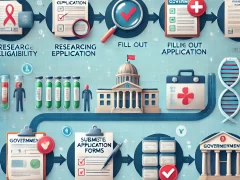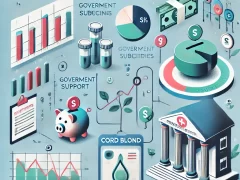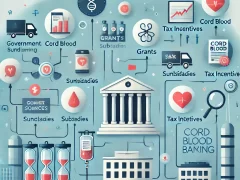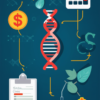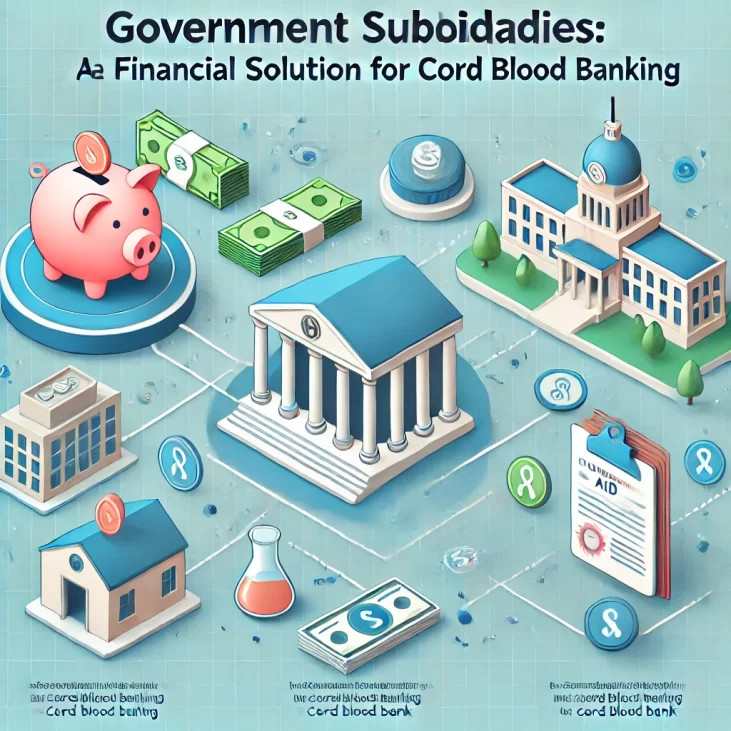
Government Subsidies: Empowering Cord Blood Banking
Unlocking Financial Stability for Cord Blood Banking
Cord blood banking has emerged as a crucial sector in the healthcare industry, offering invaluable potential for stem cell therapies and medical advancements. However, the high costs associated with establishing and maintaining a cord blood bank can be a significant barrier to entry, hindering the growth and accessibility of this vital service. In this context, government subsidies have become a crucial financial solution, empowering cord blood banking initiatives and ensuring their long-term sustainability.
Addressing the Financial Challenges of Cord Blood Banking
Cord blood banking requires substantial upfront investments for the establishment of storage facilities, laboratory equipment, and comprehensive quality control measures. Additionally, ongoing operational expenses related to sample processing, storage, and maintenance can pose a substantial financial burden for cord blood banks. These costs often translate into higher prices for families seeking to preserve their newborn’s cord blood, limiting accessibility and affordability.
The Role of Government Subsidies in Cord Blood Banking
Government subsidies can play a transformative role in overcoming the financial hurdles faced by cord blood banking. By providing financial assistance, governments can help alleviate the burden on cord blood banks, enabling them to offer more affordable services to families. This, in turn, can increase the overall participation and engagement of the public in cord blood banking, ensuring a more robust and diverse inventory of stem cell samples.
Incentivizing Cord Blood Donation and Storage
Governments can utilize subsidies to incentivize cord blood donation and storage. By offsetting the costs associated with sample collection, processing, and storage, subsidies can encourage more expectant parents to consider cord blood banking as a viable option. This not only expands the available pool of stem cell samples but also ensures that these samples are representative of diverse populations, enhancing the potential for successful stem cell therapies.
Strengthening Research and Innovation
Cord blood banking is a rapidly evolving field, with ongoing research and development aimed at improving storage techniques, increasing the viability of stored samples, and exploring new therapeutic applications. Government subsidies can provide the necessary funding to support these research initiatives, fostering innovation and advancing the field of cord blood banking. This investment in research can lead to breakthroughs that enhance the value and impact of cord blood banking for both individuals and the healthcare system as a whole.
Ensuring Equitable Access to Cord Blood Banking
One of the primary benefits of government subsidies in cord blood banking is the potential to ensure equitable access to this service. By reducing the financial barriers, subsidies can make cord blood banking more accessible to families from diverse socioeconomic backgrounds, promoting inclusivity and reducing disparities in healthcare. This aligns with the broader goal of providing equal opportunities for individuals to preserve their family’s genetic and biological assets, which can be crucial in the event of future medical needs.
Fostering Collaboration and Synergies
Government subsidies can also facilitate collaboration and synergies within the cord blood banking ecosystem. By providing financial support, governments can encourage partnerships between cord blood banks, research institutions, and healthcare providers. This collaborative approach can lead to the development of shared resources, knowledge-sharing, and the implementation of best practices, ultimately strengthening the overall cord blood banking infrastructure.
Government subsidies have emerged as a vital financial solution for the cord blood banking industry, addressing the significant costs associated with establishing and maintaining these essential healthcare services. By providing financial assistance, governments can empower cord blood banks to offer more affordable services, incentivize public participation, and support research and innovation. Ultimately, this investment in cord blood banking can lead to improved healthcare outcomes, enhanced medical research, and greater equity in access to these life-saving resources.
The Financial Implications of Cord Blood Preservation
The Financial Landscape of Cord Blood Banking
Cord blood banking has emerged as a vital healthcare solution, offering families the opportunity to preserve their newborn’s valuable stem cells for potential future medical applications. However, the financial implications of this innovative technology have become a significant consideration for many prospective parents. In this article, we will delve into the role of government subsidies in addressing the financial challenges of cord blood banking.
The Cost Conundrum of Cord Blood Preservation
Cord blood banking can be a significant financial investment for families, with initial storage fees ranging from $1,000 to $3,000, and annual storage fees of $100 to $300. These costs can be a significant barrier for many individuals, particularly those from lower-income backgrounds. Without access to financial assistance, the benefits of cord blood banking may remain out of reach for a significant portion of the population.
Government Subsidies: A Potential Solution
To address the financial hurdles associated with cord blood banking, governments around the world have implemented various subsidy programs. These initiatives aim to make cord blood preservation more accessible and affordable for families, ensuring that the life-saving potential of this technology is not limited by economic constraints.
Subsidies in Action: International Approaches
South Korea: Leading the Way
South Korea has been at the forefront of government-funded cord blood banking initiatives. The country’s National Cord Blood Program provides free cord blood banking for all newborns, with the government covering the entire cost of collection, testing, and storage. This comprehensive approach has resulted in a high participation rate and equitable access to this valuable resource.
Singapore: Targeted Assistance
In Singapore, the government has implemented a more targeted subsidy program. The country’s Cord Blood Donation Scheme offers financial assistance to families with a household income of less than $4,000 per month. This program covers up to 75% of the initial storage fees, making cord blood banking more accessible to low- and middle-income families.
United Kingdom: Public-Private Partnerships
The United Kingdom has taken a unique approach, leveraging public-private partnerships to subsidize cord blood banking. The NHS Cord Blood Bank works with private cord blood banks to offer discounted storage fees for families who meet certain income criteria. This collaborative model ensures that financial barriers are reduced, while still maintaining a diverse and readily available cord blood inventory.
The Impact of Subsidies on Cord Blood Banking
The implementation of government subsidies for cord blood banking has had a significant impact on public participation and accessibility. In countries with comprehensive subsidy programs, such as South Korea, the rates of cord blood donation and storage have soared, ensuring that a greater number of families can benefit from this life-saving technology.
Considerations for Policymakers
As governments continue to explore the potential of cord blood banking, policymakers must carefully weigh the financial implications and the long-term benefits of these programs. Factors such as cost-effectiveness, equitable access, and the potential for future medical advancements should be taken into account when designing and implementing cord blood banking subsidies.
The financial barriers associated with cord blood banking have been a significant challenge for many families. However, the introduction of government subsidies has emerged as a promising solution, making this innovative technology more accessible and affordable for a broader segment of the population. By addressing the financial implications of cord blood preservation, these subsidy programs have the potential to revolutionize the healthcare landscape and improve the lives of countless individuals in the years to come.
Exploring the Regulatory Landscape of Cord Blood Banking
The Evolving Landscape of Cord Blood Banking Regulations
The field of cord blood banking has undergone significant transformation in recent years, with a growing emphasis on the regulatory environment that governs this crucial aspect of healthcare. As the demand for cord blood stem cells continues to rise, both for medical research and therapeutic applications, the need for robust and comprehensive regulations has become increasingly apparent.
Cord blood banking operations are subject to a complex web of regulations that vary across different regions and jurisdictions. In the United States, for instance, the Food and Drug Administration (FDA) plays a central role in overseeing the collection, processing, and storage of cord blood units. The FDA’s regulations encompass a range of requirements, from donor eligibility to quality control measures, ensuring the safety and efficacy of cord blood products.
The Evolving Regulatory Landscape in the European Union
The European Union has also witnessed a steady evolution of its regulatory landscape for cord blood banking. The European Commission has established guidelines and directives that aim to harmonize the standards across member states, promoting the safe and ethical handling of cord blood units. This regulatory framework covers aspects such as donor screening, storage protocols, and the traceability of cord blood samples.
The Importance of Accreditation and Certification
In addition to national and regional regulations, cord blood banks often seek accreditation and certification from recognized organizations, such as the American Association of Blood Banks (AABB) or the Foundation for the Accreditation of Cellular Therapy (FACT). These accreditations serve as a testament to the bank’s adherence to best practices, ensuring the quality and safety of their cord blood products.
The Impact of Evolving Regulations on Cord Blood Banking
The evolving regulatory landscape has had a significant impact on the cord blood banking industry, both in terms of operational practices and the overall availability of cord blood units. Compliance with increasingly stringent regulations has led to higher costs for cord blood banks, which may be passed on to consumers in the form of higher storage fees.
The Emergence of Public-Private Partnerships
To address the challenges posed by the regulatory environment, some countries have explored the establishment of public-private partnerships in the cord blood banking sector. These partnerships aim to leverage the resources and expertise of both the public and private sectors, ensuring the availability of affordable and accessible cord blood banking services.
The Importance of Transparency and Ethical Practices
As the regulatory landscape continues to evolve, cord blood banks are under increased pressure to demonstrate transparency and adhere to ethical practices. This includes providing clear and detailed information to donors about the donation process, the storage and usage of cord blood units, and any potential commercialization or research activities.
The regulatory landscape of cord blood banking is a critical and ever-changing aspect of this dynamic healthcare sector. By navigating these complex regulations, cord blood banks can ensure the safety, quality, and accessibility of this invaluable resource, ultimately benefiting patients and advancing medical research.
Cord Blood Donation: A Philanthropic Opportunity
The Altruistic Act of Cord Blood Donation
Cord blood, the blood that remains in the umbilical cord and placenta after a baby’s birth, is a valuable resource that can save lives. Cord blood is rich in stem cells, which have the potential to treat a variety of medical conditions. By donating this precious resource, expectant parents can make a significant contribution to the field of regenerative medicine and potentially help those in need.
The Benefits of Cord Blood Donation
Cord blood donation is a philanthropic act that can have a profound impact. When parents choose to donate their child’s cord blood, they are providing an opportunity for stem cell transplants and other regenerative therapies. These stem cells can be used to treat a wide range of conditions, including blood disorders, immune system diseases, and even certain types of cancer. By donating cord blood, parents can give the gift of life to someone in need.
The Cord Blood Donation Process
The process of cord blood donation is relatively straightforward and poses no additional risk to the mother or baby. After the baby is born and the umbilical cord has been clamped, the cord blood is collected and stored in a specialized facility. The collection process is quick and painless, and it does not interfere with the birthing experience.
The Impact of Government Subsidies
Unfortunately, the cost of cord blood banking can be a barrier for many families. This is where government subsidies can play a crucial role. By providing financial support for cord blood banking, governments can encourage more parents to donate their child’s cord blood. This, in turn, can expand the available pool of stem cells and increase the chances of finding a suitable match for those in need of a transplant.
The Importance of Raising Awareness
Despite the benefits of cord blood donation, many people are still unaware of its potential. It is essential to raise awareness about the importance of this altruistic act and the role that government subsidies can play in making it more accessible. Through education and outreach campaigns, more expectant parents can be informed about the opportunity to donate their child’s cord blood and the positive impact it can have on the lives of others.
The Future of Cord Blood Donation
As the field of regenerative medicine continues to advance, the demand for cord blood stem cells is expected to grow. By encouraging and supporting cord blood donation, governments can play a vital role in addressing this growing need and improving the lives of those in need of stem cell therapies. With the right policies and initiatives in place, the future of cord blood donation can be bright, and the potential to save lives can be realized.
Cord blood donation is a remarkable philanthropic opportunity that can have a lasting impact on individuals and communities. By providing government subsidies for cord blood banking, more families can be empowered to make this altruistic choice, and the availability of this precious resource can be increased. Through increased awareness and support, the transformative potential of cord blood donation can be fully realized, paving the way for a future where regenerative therapies are more accessible and lives are saved.
Ensuring Accessibility: Addressing Cord Blood Banking Challenges
Cord blood banking has emerged as a revolutionary medical practice, offering individuals the opportunity to preserve and potentially harness their own or a family member’s stem cells for future therapeutic use. However, the accessibility and adoption of this innovative technology have been hampered by various challenges. In this article, we’ll explore the barriers to cord blood banking and examine how government subsidies can play a pivotal role in addressing these issues.
Barriers to Cord Blood Banking
One of the primary obstacles to widespread cord blood banking is the cost associated with the process. Storing cord blood can be a significant financial investment, often ranging from $1,000 to $3,000 for the initial collection and processing, followed by annual storage fees. This price tag can be daunting for many families, particularly those with limited financial resources.
Another barrier is the lack of awareness and understanding about the potential benefits of cord blood banking. Many people are simply unaware of the medical applications of stored cord blood, or they may not fully comprehend the importance of preserving this valuable resource. Educating the public and healthcare providers about the advantages of cord blood banking is crucial to increasing its adoption.
Furthermore, the infrastructure and logistics of cord blood banking can pose challenges. Establishing collection sites, maintaining proper storage facilities, and ensuring the seamless transportation of collected samples require significant investment and coordination. These logistical hurdles can hinder the accessibility of cord blood banking services, particularly in underserved or remote communities.
The Role of Government Subsidies
Government subsidies can play a vital role in addressing the challenges associated with cord blood banking. By providing financial assistance, policymakers can make this technology more accessible to a broader segment of the population.
Reducing the Financial Burden
One of the primary ways in which government subsidies can assist is by offsetting the cost of cord blood banking. Subsidies can help to cover the initial collection and processing fees, as well as the ongoing storage costs. This financial support can make cord blood banking a more affordable option for families, increasing the likelihood of participation and ensuring that those with limited resources can also benefit from this medical innovation.
Expanding Infrastructure and Access
Government funding can also be directed towards enhancing the infrastructure and accessibility of cord blood banking services. Subsidies can be used to establish new collection sites, upgrade storage facilities, and improve transportation networks. By investing in the underlying systems, the government can ensure that cord blood banking services are available to a wider geographical area, including rural and underserved communities.
Promoting Public Awareness and Education
In addition to addressing the financial and logistical barriers, government subsidies can also be leveraged to increase public awareness and understanding of cord blood banking. Funding can be allocated to educational campaigns, informational resources, and collaborations with healthcare providers. By enhancing public knowledge, the government can empower individuals to make informed decisions about preserving their family’s stem cell resources.
Cord blood banking holds immense promise for the future of regenerative medicine, but its accessibility has been hindered by various challenges. Government subsidies can play a crucial role in overcoming these obstacles, making cord blood banking a viable and accessible option for families across the socioeconomic spectrum. By reducing the financial burden, expanding the infrastructure, and promoting public awareness, government support can help to ensure that the benefits of this revolutionary technology are available to all.
Conclusion
Government subsidies have the potential to revolutionize the cord blood banking industry, making this invaluable resource more accessible to individuals and families. By addressing the financial challenges associated with cord blood preservation, these subsidies can empower more people to take advantage of this life-saving technology.
The financial implications of cord blood banking are significant, with the costs of collection, processing, and long-term storage posing a significant barrier for many. Government subsidies can help alleviate these financial burdens, ensuring that more individuals can afford to preserve their child’s cord blood for potential future use.
Exploring the regulatory landscape of cord blood banking is crucial, as it ensures that the industry operates within strict guidelines and maintains the highest standards of safety and quality. Government involvement in this process can provide the necessary oversight and guidance to ensure that cord blood banking remains a reliable and trustworthy option for families.
Cord blood donation, a philanthropic act that can save lives, has the potential to become more widespread with the support of government subsidies. By making it more affordable for individuals to donate their child’s cord blood, these subsidies can increase the available supply of this vital resource and ultimately benefit those in need of stem cell transplants.
Ensuring the accessibility of cord blood banking is essential. Government subsidies can help address the challenges that have historically hindered widespread adoption, such as lack of awareness, transportation barriers, and cultural or linguistic differences. By making cord blood banking more inclusive and available to diverse communities, these subsidies can truly transform the landscape of this critical healthcare sector.
Government subsidies represent a powerful solution to the financial barriers that have long been a significant obstacle in the cord blood banking industry. By empowering more individuals to preserve and donate their child’s cord blood, these subsidies have the potential to save countless lives and revolutionize the way we approach this invaluable resource. As the regulatory landscape continues to evolve and the importance of cord blood banking becomes increasingly recognized, the role of government subsidies will only become more vital in ensuring the accessibility and viability of this life-saving technology.


